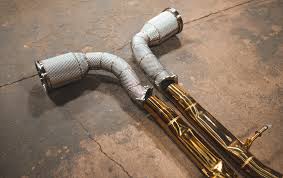There’s something strangely peaceful about sitting down with a cup of coffee and thinking about cars — not in that loud, overly-technical way, but in a slower, more reflective sense. You know, the way you might talk about a hobby you genuinely enjoy, not one you’re trying to justify or show off. Performance tuning, especially, has that weird duality. It’s equal parts science experiment and emotional expression, depending on who you ask.
And among the rabbit holes you can fall into, downpipes have this almost humble reputation. They’re not glamorous or Instagram-friendly, and most people won’t even notice them unless they’re listening closely. Yet enthusiasts know how deeply they can change a car’s character — not dramatically, not theatrically, but meaningfully. Those quiet improvements often stick with you the most.
But before diving too deep, there’s something comforting about understanding why people modify their cars in the first place. With some cars, especially the powerful German sedans and exotic SUVs we’re talking about today, it’s not about chasing numbers. Most of these vehicles already make more power than people realistically use. It’s about feel — the sensation behind the wheel, the breath of the engine, the personality of the machine.
Take the E63 for instance. There’s a kind of old-school AMG soul hiding inside that car, even though it’s wrapped in modern refinement. It’s brutal when you want it to be, yet surprisingly composed when you’re just cruising around. Owners often describe it with a kind of affectionate frustration — like, “This car is incredible, but I know it can give just a little bit more.” That’s usually where the conversations about mercedes e63 w213 catted and catless downpipes quietly come in. Not as a sales pitch, not as some dramatic promise, but as a simple observation: the engine breathes better. The exhaust wakes up, the turbos respond more sharply, and the car feels less restricted. It’s like removing a tight collar from a very powerful dog — suddenly it moves the way it was meant to.
What’s interesting about the E63 community is how thoughtful most owners are. They’re not trying to turn their car into a track animal, nor are they chasing the loudest cold start in the neighborhood. They want refinement. They want balance. They want the car to feel like the version of itself that Mercedes hinted at but didn’t fully release. And honestly, you can’t blame them — the platform is capable of so much once you let it breathe.
Now, shifting from the E63’s controlled aggression to the Lamborghini Urus is like switching from a calm conversation to a loud, excited story someone tells with their hands. The Urus doesn’t try to hide its personality. It’s bold, dramatic, and impossible to ignore. Even standing still, it feels like it’s waiting for something exciting to happen. But that energy, as wild as it seems, is also shaped and softened by factory design choices intended for comfort, emissions, and mass-market sensibility.
Which, naturally, explains why enthusiasts start exploring lamborghini urus downpipes when they want the SUV to sound and respond more like the raging bull it pretends not to be. This isn’t about trying to “fix” the Urus — it’s about unlocking the tone and urgency sitting just beneath the surface. A good downpipe on that engine adds depth to the exhaust note, sharpens the throttle response, and transforms the vibration of acceleration into something richer and more satisfying. Not necessarily louder, but fuller — like the difference between a cheap speaker and a proper sound system.
And what I find both amusing and relatable is how similar the reasoning is across completely different types of owners. Whether it’s a Mercedes driver who likes subtlety or an Urus owner who enjoys making an entrance, the core desire is the same: connection. People want their cars to reflect a bit of themselves — their taste, their personality, their mood behind the wheel.
There’s something very human about that. Machines are supposed to be neutral, logical, unemotional… yet we treat them like companions. We listen to them. We talk about them like characters. We celebrate their strengths and excuse their flaws. Modifying a car isn’t just about performance — it’s about shaping an experience. And downpipes, oddly enough, are one of the clearest expressions of that philosophy.
They don’t change the look of the car. You can’t really show them off. They’re not part of some dramatic transformation. But they change the feel in a way that stays with you. A smoother pull. A cleaner tone. A bit more life in the engine. Something you notice on morning drives, on long nights, on roads you’ve driven a hundred times.
And I think that’s why these upgrades resonate so much. Not because people want bragging rights, but because they enjoy feeling more connected to something they already love. It’s like tuning an instrument rather than replacing it. Subtle adjustments, small refinements, all adding up to a more expressive performance.
Of course, there’s always the practical side — the research, the comparisons, the endless forum threads where five different people swear their setup is the “only correct one.” The tuning community can be chaotic, opinionated, overwhelming. But beneath all the noise, there’s a simple truth: choose the upgrade that aligns with the way you drive, not the way strangers think you should.

